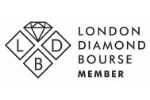Carriage Diamonds Knowledge Centre - The 4 Cs and more
What you really need to know is what you want and what you like and your budget.
It will probably work in reverse order to that-
You have a rough budget and then you set out to do your research and see what is the 'best' you can get for that amount.
Let me offer you a simple take on the whole process and what your main considerations are. If you want some in-depth information at the end, you can watch the guide provided by the most respected diamond education source, the Gemmological Institute of America, who were the creators of the 'Four Cs in the 1930s'.
For now, this should really help you.
We'll use the famous Four Cs to help though....
1. Cut
What are all the different diamond cuts and therefore shapes that you can choose from? Which one speaks to you? Does the idea of wearing a particular shape diamond excite you?

The way a diamond sparkles (its brilliance and scintillation) and the amount of 'rainbow colour flashes' (fire) that come off of it is determined by its cut. These attributes will vary in their degrees between, for example, the classic round brilliant and a baguette, where the first stone has more facets for example and therefore sparkles more.
You need to sit and experience these stones and differences personally to fully understand which you prefer.
2. The rest: Carat, Colour, Clarity
How technically perfect a stone do you want it to be? Are you willing to go a few tiny notches down from the perfect colourless diamond grade in order to have a slightly larger stone? That's what you really need to work out
Here's how it goes:
- The larger the stone, the more expensive. Exponentially so once you hit certain sizes just under and certainly over the 1carat size.
- The better the colour grading ie. F rather than G, the more expensive.
- The 'cleaner' the stone, again, the more expensive.
A few key details for you to be aware of:
Carat ie. weight and size.

This scale gives you a good idea of how large or small the stone you want is, in points and carats. There are 100 points in a carat so half a carat is 50 points, as you see above.
Colour
This element is very subjective and hence the factor that you can probably play with most. Nearly all the diamonds offered for an engagement ring, certainly at Carriage, will be largely colourless but possibly with tiny tinges of yellow or brown-much of which you actually need a trained eye to see.
If you are buying an engagement ring, then the range of colours tends to be between E and H.
Clarity
Again here, to the untrained eye, you can probably give yourself quite some flexibility.
This diamond characteristic is shown using the letters 'VS' meaning 'very small' and with the number 1 or 2 present or missing. VS1 is a reference to 'very small inclusions'.
NB! It is generally understood that diamonds with clarities of IF, VVS1, VVS2, VS1, VS2, SI1, SI2, are "eye clean" i.e. clean to an unaided eye looking straight down onto the flat surface of the stone at a distance of 25 cm.
Carriage offers only diamonds which:
- Are Certificated
- Neither colour nor clarity treated and hence 100% natural
- Not 'conflict'
A diamond certificate is a document issued by a world trusted gemological laboratory including the GIA, EGL, IGI. At the lab, the diamond is analysed and evaluated in order to provide details on the exact characteristics of that stone including such elements as it clarity, colour, the precision of its cut. It is given its own reference number.
Treatments are often carried out on diamonds of a secondary quality in order to enhance their appearance and thus their value. They may be highly heat-treated or laser drilled to change their colour or remove inclusions.
Conflict or 'blood' diamonds are those that are exported from countries where the mines are in the hands of warlords and thus the money used from the sale of these diamonds is for illegal conflict.
Who do we use to certify our diamonds?
We use two Diamond Gemological institutions in order to grade our diamonds.

